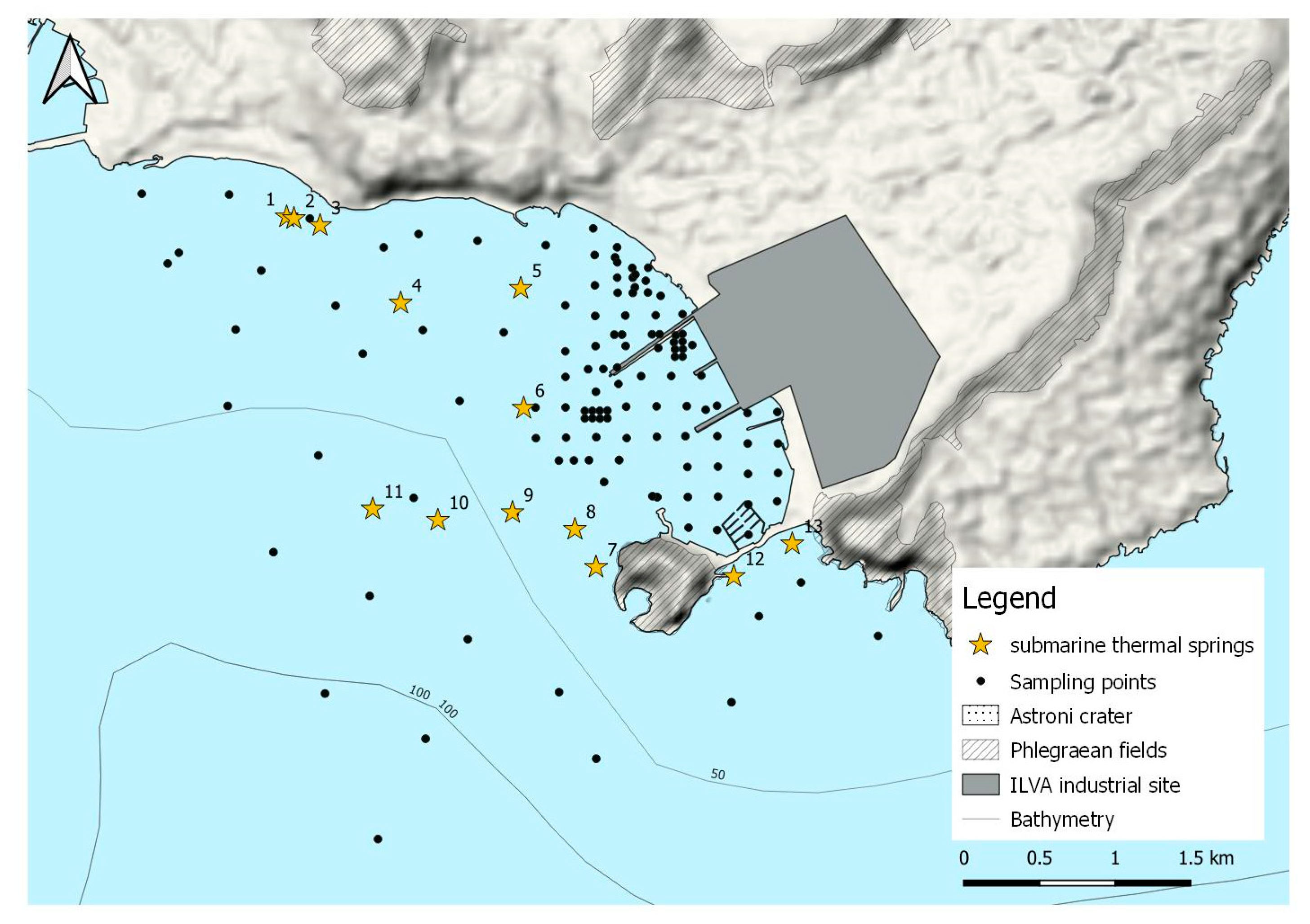Source Apportionment Assessment of Marine Sediment Contamination in a Post-Industrial Area (Bagnoli, Naples)
Abstract
:1. Introduction
2. Materials and Methods
2.1. Study Area and Geological Settings
2.2. Data Availability: Sampling, Sewage Discharge, and Wave Information
2.3. Numerical Wave Modelling
- The WAM offshore hindcast data, consisting in an amplification of each value of WAM dataset by means of an “enhancement factor”. The enhancement factor has been obtained by comparison of WAM hindcast dataset at a point located offshore the study area and the time series obtained by transposition of the available data from an offshore wave buoy record. Then, the fictitious WAM time series has been used as input for the numerical model.
- The nearshores wave propagation model output, applying a two-step calibration strategy by comparison with measurements from acoustic Doppler current profilers and a set of innovative low-cost drifter-derived GPS-based wave buoys [47] located both inside and outside the GoP.
2.4. Statistical Analysis: Multivariate Analysis and Bivariate Correlation
3. Results
3.1. PCA and PCs Extraction
- F1 accounts for 38.3% of the variance and it is loaded mostly by PAHs and by some heavy metals (i.e., Cd, Cu, Fe).
- F2 accounts for 35.4% of the variance and it is loaded by the remaining PAHs with a lower molecular weight and higher vapor pressure.
- F3 accounts for 6.8% of the variance and it is loaded by Cr, Ni and V.
- F4 accounts for 5.5% of the variance and it is loaded by As.
3.2. Factors vs. Sewage Discharges
3.3. Factors vs. Thermal Springs
3.4. Pollution Patterns and Wave Hydrodynamics
- F1, loaded by the heavier PAH compounds and by some heavy metals and F4 loaded by arsenic, were both found significantly influenced by wave hydrodynamics (test results were respectively H: 12.9; df: 3, P < 0.01; and H: 51; df: 3, P < 0.01).
- F2, loaded by the lighter PAHs, and F3, loaded by chromium, nickel and vanadium were not found influenced by the wave hydrodynamics (P > 0.05).
4. Discussion
5. Conclusions
Supplementary Materials
Author Contributions
Funding
Acknowledgments
Conflicts of Interest
References
- Richir, J.; Salivas-Decaux, M.; Lafabrie, C.; Lopez y Royo, C.; Gobert, S.; Pergent, G.; Pergent-Martini, C. Bioassessment of trace element contamination of Mediterranean coastal waters using the seagrass Posidonia oceanica. J. Environ. Manag. 2015, 151, 486–499. [Google Scholar] [CrossRef] [PubMed]
- Morroni, L.; d’Errico, G.; Sacchi, M.; Molisso, F.; Armiento, G.; Chiavarini, S.; Rimauro, J.; Guida, M.; Siciliano, A.; Ceparano, M.; et al. Integrated characterization and risk management of marine sediments: The case study of the industrialized Bagnoli area (Naples, Italy). Mar. Environ. Res. 2020, 160, 104984. [Google Scholar] [CrossRef]
- Romano, E.; Ausili, A.; Zharova, N.; Celia Magno, M.; Pavoni, B.; Gabellini, M. Marine sediment contamination of an industrial site at Port of Bagnoli, Gulf of Naples, Southern Italy. Mar. Pollut. Bull. 2004, 49, 487–495. [Google Scholar] [CrossRef] [PubMed]
- Armiento, G.; Caprioli, R.; Cerbone, A.; Chiavarini, S.; Crovato, C.; De Cassan, M.; De Rosa, L.; Montereali, M.R.; Nardi, E.; Nardi, L.; et al. Current status of coastal sediments contamination in the former industrial area of Bagnoli-Coroglio (Naples, Italy). Chem. Ecol. 2020, 36(6), 579–597. [Google Scholar] [CrossRef]
- Arienzo, M.; Donadio, C.; Mangoni, O.; Bolinesi, F.; Stanislao, C.; Trifuoggi, M.; Toscanesi, M.; Di Natale, G.; Ferrara, L. Characterization and source apportionment of polycyclic aromatic hydrocarbons (pahs) in the sediments of gulf of Pozzuoli (Campania, Italy). Mar. Pollut. Bull. 2017, 124, 480–487. [Google Scholar] [CrossRef]
- Romano, E.; Bergamin, L.; Celia Magno, M.; Pierfranceschi, G.; Ausili, A. Temporal changes of metal and trace element contamination in marine sediments due to a steel plant: The case study of Bagnoli (Naples, Italy). Appl. Geochem. 2018, 88, 85–94. [Google Scholar] [CrossRef]
- Trifuoggi, M.; Donadio, C.; Mangoni, O.; Ferrara, L.; Bolinesi, F.; Nastro, R.A.; Stanislao, C.; Toscanesi, M.; Di Natale, G.; Arienzo, M. Distribution and enrichment of trace metals in surface marine sediments in the Gulf of Pozzuoli and off the coast of the brownfield metallurgical site of Ilva of Bagnoli (Campania, Italy). Mar. Pollut. Bull. 2017, 124, 502–511. [Google Scholar] [CrossRef]
- Bertocci, I.; Dell’Anno, A.; Musco, L.; Gambi, C.; Saggiomo, V.; Cannavacciuolo, M.; Lo Martire, M.; Passarelli, A.; Zazo, G.; Danovaro, R. Multiple human pressures in coastal habitats: Variation of meiofaunal assemblages associated with sewage discharge in a post-industrial area. Sci. Total Environ. 2019, 655, 1218–1231. [Google Scholar] [CrossRef]
- Jenkins, S.H. Mediterranean Coastal Pollution: Proceedings of a Conference Held in Palma; Pergamon Press: New York, NY, USA, 1980. [Google Scholar]
- Regoli, F.; Giuliani, M.E. Oxidative pathways of chemical toxicity and oxidative stress biomarkers in marine organisms. Mar. Environ. Res. 2014, 93, 106–117. [Google Scholar] [CrossRef]
- Regoli, F.; d’Errico, G.; Nardi, A.; Mezzelani, M.; Fattorini, D.; Benedetti, M.; Di Carlo, M.; Pellegrini, D.; Gorbi, S. Application of a weight of evidence approach for monitoring complex environmental scenarios: The case-study of off-shore platforms. Front. Mar. Sci. 2019, 6, 377. [Google Scholar] [CrossRef]
- Menghan, W.; Stefano, A.; Annamaria, L.; Claudia, C.; Antonio, C.; Wanjun, L.; Marco, S.; Angela, D.; Benedetto, D.V. Compositional analysis and pollution impact assessment: A case study in the Gulfs of Naples and Salerno. Estuar. Coast. Shelf Sci. 2015, 160, 22–32. [Google Scholar] [CrossRef]
- Chapman, P.M. Determining when contamination is pollution—Weight of evidence determinations for sediments and effluents. Environ. Int. 2007, 33, 492–501. [Google Scholar] [CrossRef] [PubMed]
- Colombo, L.; Alberti, L.; Mazzon, P.; Formentin, G. Transient Flow and Transport Modelling of an Historical CHC Source in North-West Milano. Water 2019, 11, 1745. [Google Scholar] [CrossRef] [Green Version]
- Stevenazzi, S.; Masetti, M.; Beretta, G. Pietro Groundwater vulnerability assessment: From overlay methods to statistical methods in the Lombardy Plain area. Acque Sotter.-Ital. J. Groundw. 2017, 6, 1–11. [Google Scholar]
- Troise, C.; De Natale, G.; Schiavone, R.; Somma, R.; Moretti, R. The Campi Flegrei caldera unrest: Discriminating magma intrusions from hydrothermal effects and implications for possible evolution. Earth-Sci. Rev. 2019, 188, 108–122. [Google Scholar] [CrossRef]
- Rotiroti, M.; Sacchi, E.; Fumagalli, L.; Bonomi, T. Origin of Arsenic in Groundwater from the Multilayer Aquifer in Cremona (Northern Italy). Environ. Sci. Technol. 2014, 48, 5395–5403. [Google Scholar] [CrossRef]
- Albanese, S.; De Vivo, B.; Lima, A.; Cicchella, D.; Civitillo, D.; Cosenza, A. Geochemical baselines and risk assessment of the Bagnoli brownfield site coastal sea sediments (Naples, Italy). J. Geochem. Explor. 2010, 105, 19–33. [Google Scholar] [CrossRef]
- Somma, R.; Iuliano, S.; Matano, F.; Molisso, F.; Passaro, S.; Sacchi, M.; Troise, C.; De Natale, G. High-resolution morpho-bathymetry of Pozzuoli Bay, southern Italy. J. Maps 2016, 12, 222–230. [Google Scholar] [CrossRef]
- Idowu, O.; Carbery, M.; O’Connor, W.; Thavamani, P. Speciation and source apportionment of polycyclic aromatic compounds (PACs) in sediments of the largest salt water lake of Australia. Chemosphere 2020, 246, 125779. [Google Scholar] [CrossRef]
- Yuanan, H.; He, K.; Sun, Z.; Chen, G.; Cheng, H. Quantitative source apportionment of heavy metal(loid)s in the agricultural soils of an industrializing region and associated model uncertainty. J. Hazard. Mater. 2020, 391, 122244. [Google Scholar] [CrossRef]
- Henriksson, S.; Hagberg, J.; Bäckström, M.; Persson, I.; Lindström, G. Assessment of PCDD/Fs levels in soil at a contaminated sawmill site in Sweden—A GIS and PCA approach to interpret the contamination pattern and distribution. Environ. Pollut. 2013, 180, 19–26. [Google Scholar] [CrossRef] [PubMed]
- Meng, L.; Zuo, R.; Wang, J.-S.; Yang, J.; Teng, Y.-G.; Shi, R.-T.; Zhai, Y.-Z. Apportionment and evolution of pollution sources in a typical riverside groundwater resource area using PCA-APCS-MLR model. J. Contam. Hydrol. 2018, 218, 70–83. [Google Scholar] [CrossRef] [PubMed]
- Rahman, M.S.; Hossain, M.B.; Babu, S.M.O.F.; Rahman, M.; Ahmed, A.S.S.; Jolly, Y.N.; Choudhury, T.R.; Begum, B.A.; Kabir, J.; Akter, S. Source of metal contamination in sediment, their ecological risk, and phytoremediation ability of the studied mangrove plants in ship breaking area, Bangladesh. Mar. Pollut. Bull. 2019, 141, 137–146. [Google Scholar] [CrossRef] [PubMed]
- Azzellino, A.; Colombo, L.; Lombi, S.; Marchesi, V.; Piana, A.; Merri, A.; Alberti, L. Groundwater diffuse pollution in functional urban areas: The need to define anthropogenic diffuse pollution background levels. Sci. Total Environ. 2019, 656, 1207–1222. [Google Scholar] [CrossRef]
- Alamdar, R.; Kumar, V.; Moghtaderi, T.; Naghibi, S.J. Groundwater quality evaluation of Shiraz City, Iran using multivariate and geostatistical techniques. SN Appl. Sci. 2019, 1, 1367. [Google Scholar] [CrossRef] [Green Version]
- Sheikhy Narany, T.; Ramli, M.F.; Aris, A.Z.; Sulaiman, W.N.A.; Fakharian, K. Spatiotemporal variation of groundwater quality using integrated multivariate statistical and geostatistical approaches in Amol-Babol Plain, Iran. Environ. Monit. Assess. 2014, 186, 5797–5815. [Google Scholar] [CrossRef]
- Lattuada, M.; Albrecht, C.; Wilke, T. Differential impact of anthropogenic pressures on Caspian Sea ecoregions. Mar. Pollut. Bull. 2019, 142, 274–281. [Google Scholar] [CrossRef] [Green Version]
- Bajt, O.; Ramšak, A.; Milun, V.; Andral, B.; Romanelli, G.; Scarpato, A.; Mitrić, M.; Kupusović, T.; Kljajić, Z.; Angelidis, M.; et al. Assessing chemical contamination in the coastal waters of the Adriatic Sea using active mussel biomonitoring with Mytilus galloprovincialis. Mar. Pollut. Bull. 2019, 141, 283–298. [Google Scholar] [CrossRef]
- Stefania, G.A.; Rotiroti, M.; Buerge, I.J.; Zanotti, C.; Nava, V.; Leoni, B.; Fumagalli, L.; Bonomi, T. Identification of groundwater pollution sources in a landfill site using artificial sweeteners, multivariate analysis and transport modeling. Waste Manag. 2019, 95, 116–128. [Google Scholar] [CrossRef]
- Romano, E.; Bergamin, L.; Ausili, A.; Pierfranceschi, G.; Maggi, C.; Sesta, G.; Gabellini, M. The impact of the Bagnoli industrial site (Naples, Italy) on sea-bottom environment. Chemical and textural features of sediments and the related response of benthic foraminifera. Mar. Pollut. Bull. 2009, 59, 245–256. [Google Scholar] [CrossRef]
- Sinaei, M.; Zare, R. Polycyclic aromatic hydrocarbons (PAHs) and some biomarkers in the green sea turtles (Chelonia mydas). Mar. Pollut. Bull. 2019, 146, 336–342. [Google Scholar] [CrossRef] [PubMed]
- Gambi, C.; Dell’Anno, A.; Corinaldesi, C.; Lo Martire, M.; Musco, L.; Da Ros, Z.; Armiento, G.; Danovaro, R. Impact of historical contamination on meiofaunal assemblages: The case study of the Bagnoli-Coroglio Bay (southern Tyrrhenian Sea). Mar. Environ. Res. 2020, 156, 104907. [Google Scholar] [CrossRef] [PubMed]
- Tangherlini, A.; Corinaldesi, M.; Rastelli, C.; Musco, E.; Armiento, L.; Danovaro, G.; Dell’Anno, R. Chemical contamination can promote turnover diversity of benthic prokaryotic assemblages: The case study of the Bagnoli-Coroglio bay (Southern Tyrrhenian Sea). Mar. Environ. Res. 2020, in press. [Google Scholar] [CrossRef]
- Soclo, H.H.; Garrigues, P.; Ewald, M. Origin of polycyclic aromatic hydrocarbons (PAHs) in coastal marine sediments: Case studies in Cotonou (Benin) and Aquitaine (France) Areas. Mar. Pollut. Bull. 2000, 40, 387–396. [Google Scholar] [CrossRef]
- Del Gaudio, C.; Aquino, I.; Ricciardi, G.P.; Ricco, C.; Scandone, R. Unrest episodes at Campi Flegrei: A reconstruction of vertical ground movements during 1905–2009. J. Volcanol. Geotherm. Res. 2010, 195, 48–56. [Google Scholar] [CrossRef]
- Lima, A.; De Vivo, B.; Spera, F.J.; Bodnar, R.J.; Milia, A.; Nunziata, C.; Belkin, H.E.; Cannatelli, C. Thermodynamic model for uplift and deflation episodes (bradyseism) associated with magmatic-hydrothermal activity at the Campi Flegrei (Italy). Earth-Sci. Rev. 2009, 97, 44–58. [Google Scholar] [CrossRef]
- Isaia, R.; Vitale, S.; Marturano, A.; Aiello, G.; Barra, D.; Ciarcia, S.; Iannuzzi, E.; Tramparulo, F.D.A. High-resolution geological investigations to reconstruct the long-term ground movements in the last 15 kyr at Campi Flegrei caldera (southern Italy). J. Volcanol. Geotherm. Res. 2019, 385, 143–158. [Google Scholar] [CrossRef]
- Rosi, M.; Sbrana, A.; Principe, C. The phlegraean fields: Structural evolution, volcanic history and eruptive mechanisms. J. Volcanol. Geotherm. Res. 1983, 17, 273–288. [Google Scholar] [CrossRef]
- Sellerino, M.; Forte, G.; Ducci, D. Identification of the natural background levels in the Phlaegrean fields groundwater body (Southern Italy). J. Geochemical Explor. 2019, 200, 181–192. [Google Scholar] [CrossRef]
- De Vivo, B.; Lima, A. Characterization and Remediation of a Brownfield Site. The Bagnoli Case in Italy; Elsevier B.V.: Amsterdam, The Netherlands, 2008. [Google Scholar]
- ABBaCo Project, 2018. Sperimentazioni Pilota Finalizzate al Restauro Ambientale e Balneabilità del SIN Bagnoli-Coroglio. 2018. Available online: http://www.szn.it/index.php/en/research/integrative-marine-ecology/research-projects-emi/abbaco (accessed on 8 July 2020).
- Musco, L.; Bertocci, I.; Buia, M.C.; Cannavacciuolo, M.; Conversano, F.; Gallo, A.; Gambi, M.C.; Ianora, A.; Iudicone, D.; Margiotta, F.; et al. Restauro ambientale e balneabilità a del SIN di Bagnoli Coroglio-Progetto ABBaCo Workshop SiCon2017. Siti contaminati. In Proceedings of the Esperienze Negli Interventi di Risanamento. Roma, Facoltà Ingegneria Civile ed Industriale. La Sapienza, Roma, Italy, 8–10 February 2017. [Google Scholar]
- European Centre for Medium-Range Weather Forecasts. Available online: http://www.ecmwf.int/ (accessed on 8 July 2020).
- Dhi Water and Environment. Available online: https://www.dhigroup.com/ (accessed on 8 July 2020).
- Contestabile, P.; Conversano, F.; Centurioni, L.; Golia, U.M.; Musco, L.; Danovaro, R.; Vicinanza, D. Multi-collocation-based estimation of wave climate in a non-tidal bay: The case study of Bagnoli-Coroglio bay (Tyrrhenian Sea). Water 2020, 12, 1936. [Google Scholar] [CrossRef]
- Centurioni, L.; Braasch, L.; Di Lauro, E.; Contestabile, P.; De Leo, F.; Casotti, R.; Franco, L.; Vicinanza, D. A New strategic wave measurement station off Naples Port main breakwater. Coast. Eng. Proc. 2017, 1, 36. [Google Scholar] [CrossRef] [Green Version]
- Holthuijsen, L.H. Waves in oceanic and coastal waters. Waves Ocean. Coast. Waters 2007, 9780521860, 1–387. [Google Scholar]
- Contestabile, P.; Vicinanza, D. Coastal defence integratingwave-energy-based desalination: A case study in Madagascar. J. Mar. Sci. Eng. 2018, 6, 64. [Google Scholar] [CrossRef] [Green Version]
- Contestabile, P.; Di Lauro, E.; Galli, P.; Corselli, C.; Vicinanza, D. Offshore Wind and Wave Energy Assessment around Malè and Magoodhoo Island (Maldives). Sustainability 2017, 9, 613. [Google Scholar] [CrossRef] [Green Version]
- General Bathymetric Chart of the Oceans. Available online: http://www.gebco.net/ (accessed on 8 July 2020).
- Afifi, A.; May, S.; Clark, V.A. Cluster analysis. In Computer-Aided Multivariate Analysis; Chapman & Hall-CRC Press: London, UK, 2003. [Google Scholar]
- Baltas, H.; Sirin, M.; Dalgic, G.; Bayrak, E.Y.; Akdeniz, A. Assessment of metal concentrations (Cu, Zn, and Pb) in seawater, sediment and biota samples in the coastal area of Eastern Black Sea, Turkey. Mar. Pollut. Bull. 2017, 122, 475–482. [Google Scholar] [CrossRef]
- Safakhah, N.; Ghanemi, K.; Nikpour, Y.; Batvandi, Z. Occurrence, distribution, and risk assessment of bisphenol A in the surface sediments of Musa estuary and its tributaries in the northern end of the Persian Gulf, Iran. Mar. Pollut. Bull. 2020, 156, 111241. [Google Scholar] [CrossRef]
- Kim, S.; Lee, Y.S.; Moon, H.B. Occurrence, distribution, and sources of phthalates and non-phthalate plasticizers in sediment from semi-enclosed bays of Korea. Mar. Pollut. Bull. 2020, 151, 110824. [Google Scholar] [CrossRef]
- Renzi, M.; Romeo, T.; Guerranti, C.; Perra, G.; Italiano, F.; Focardi, S.E.; Esposito, V.; Andaloro, F. Temporal trends and matrix-dependent behaviors of trace elements closed to a geothermal hot-spot source (Aeolian Archipelago, Italy). Procedia Earth Planet. Sci. 2011, 4, 10–28. [Google Scholar] [CrossRef] [Green Version]
- Valentino, G.M.; Stanzione, D. Source processes of the thermal waters from the Phlegraean Fields (Naples, Italy) by means of the study of selected minor and trace elements distribution. Chem. Geol. 2003, 194, 245–274. [Google Scholar] [CrossRef]
- Aiuppa, A.; Avino, R.; Brusca, L.; Caliro, S.; Chiodini, G.; D’Alessandro, W.; Favara, R.; Federico, C.; Ginevra, W.; Inguaggiato, S.; et al. Mineral control of arsenic content in thermal waters from volcano-hosted hydrothermal systems: Insights from island of Ischia and Phlegrean Fields (Campanian Volcanic Province, Italy). Chem. Geol. 2006, 229, 313–330. [Google Scholar] [CrossRef]
- Celico, P.; Dall’Aglio, M.; Ghiara, M.R.; Stanzione, D.; Brondi, M.; Prosperi, M. Geochemical monitoring of the thermal fluids in the Phlegeran Fields from 1970 to 1990. Boll. Soc. Geol. Ital. 1992, 111, 409–442. [Google Scholar]
- De Vivo, B.; Lima, A. The Bagnoli-Napoli Brownfield Site in Italy: Before and After the Remediation, 2nd ed.; Elsevier B.V.: Amsterdam, The Netherlands, 2018. [Google Scholar]
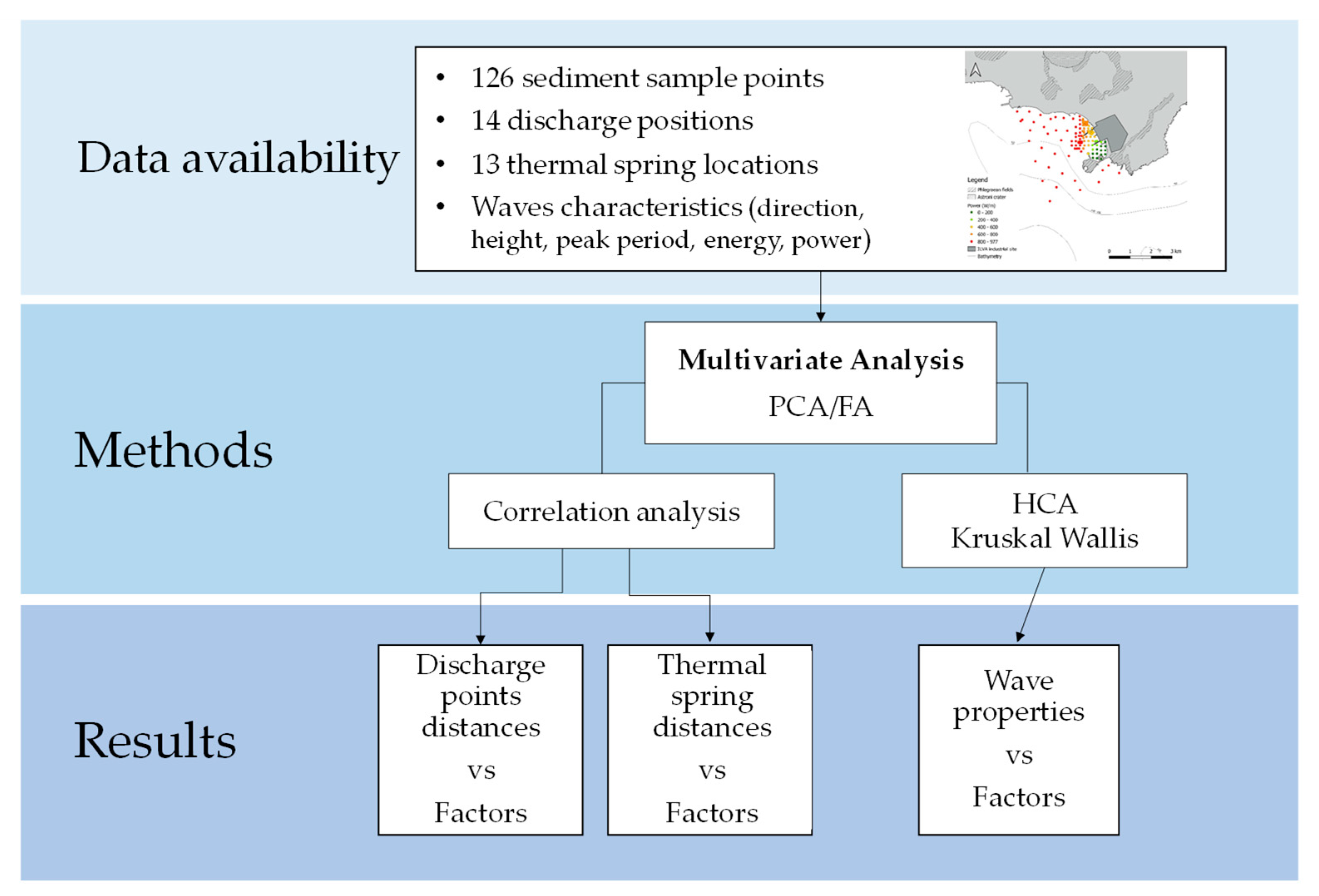
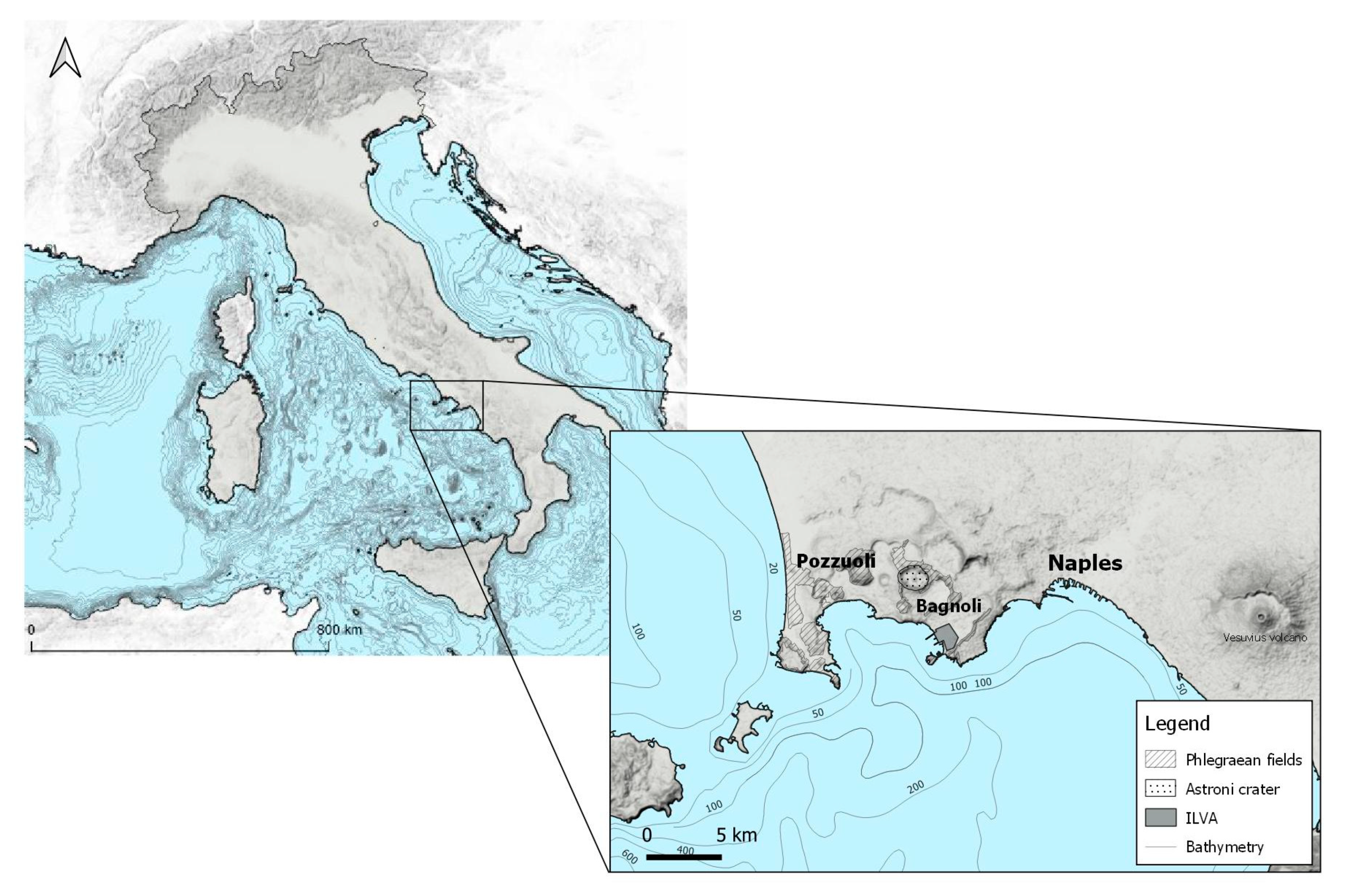
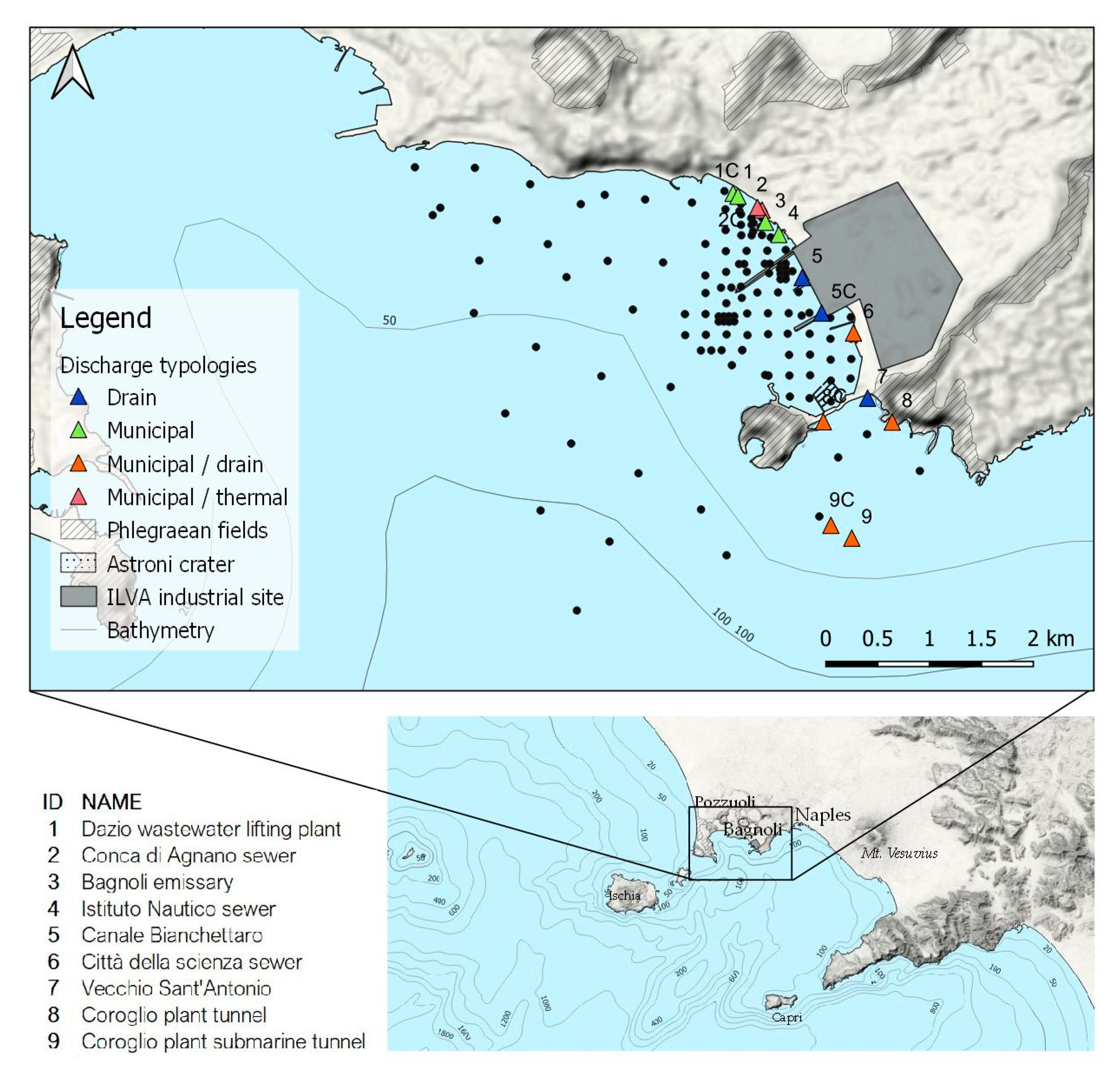

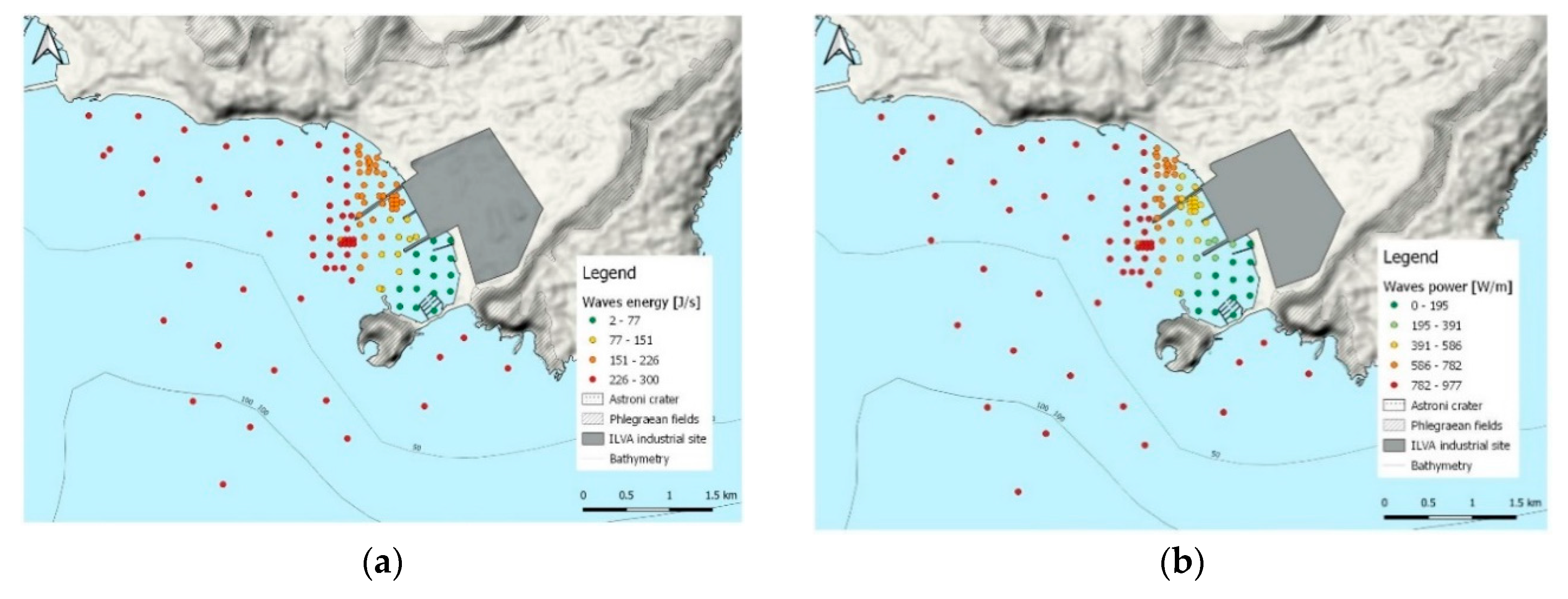
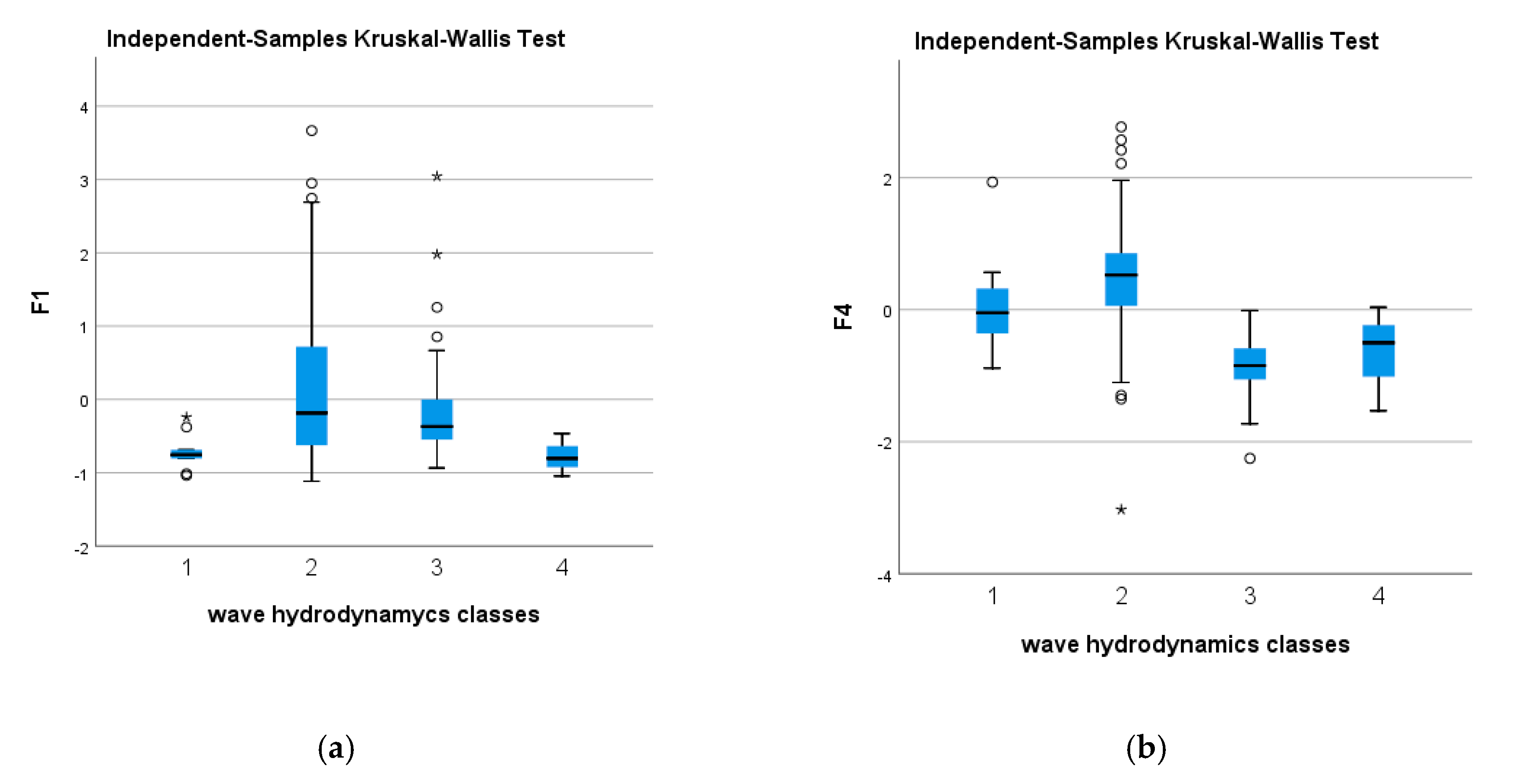
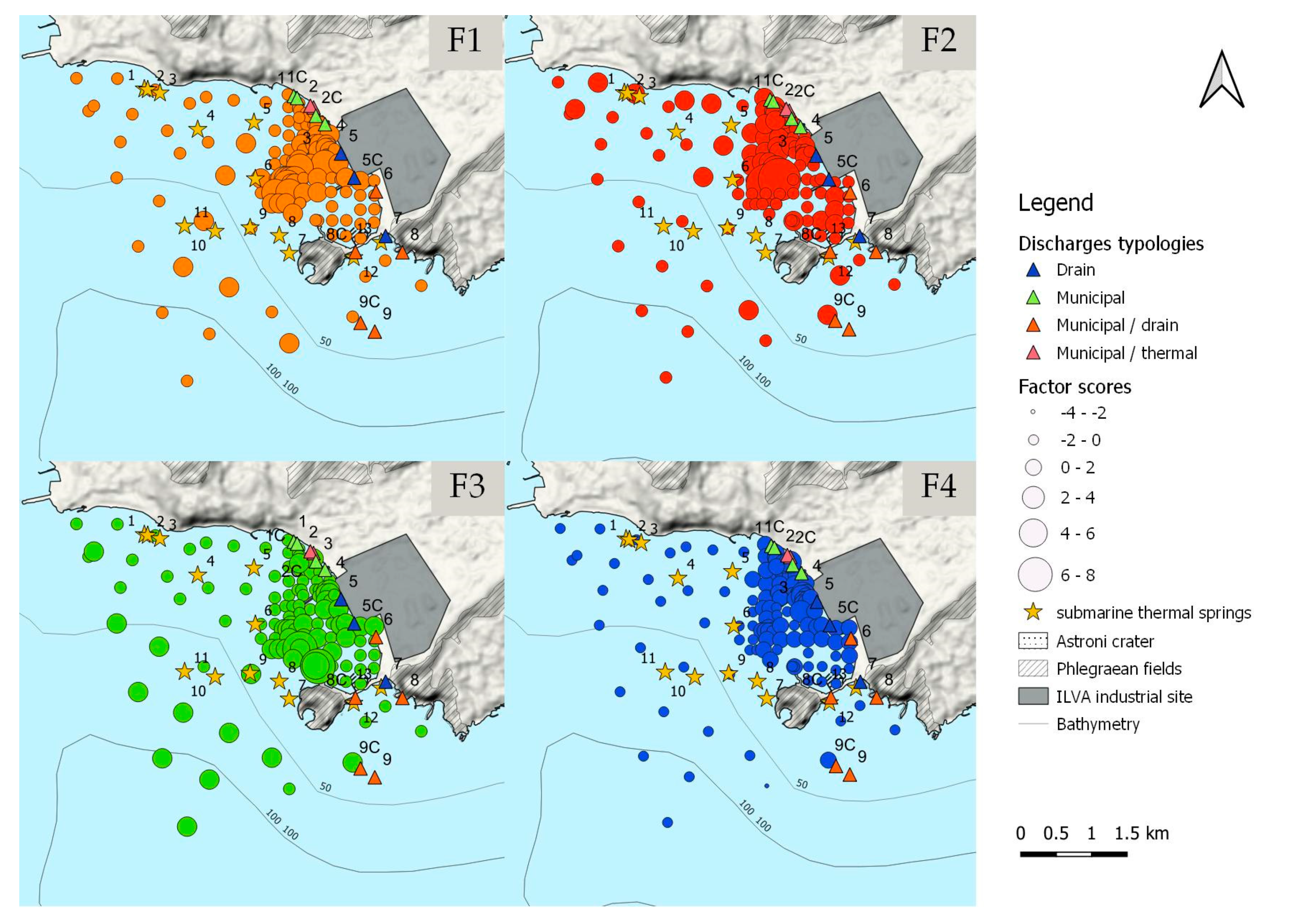
| Contaminant | N | Minimum | Maximum | Mean | Std. Deviation |
|---|---|---|---|---|---|
| Aluminum (Al) | 126 | 27827.37 | 92240.68 | 65268.54 | 16565.95 |
| Arsenic (As) | 126 | 18.66 | 136.66 | 64.32 | 24.59 |
| Cadmium (Cd) | 126 | 0.26 | 14.65 | 2.03 | 2.96 |
| Chromium (Cr) | 126 | 11.16 | 1022.02 | 51.62 | 108.50 |
| Copper (Cu) | 126 | 6.64 | 209.58 | 48.38 | 42.17 |
| Iron (Fe) | 126 | 21578.56 | 209372.34 | 76045.46 | 45464.22 |
| Mercury (Hg) | 126 | 0.01 | 7.51 | 0.73 | 1.02 |
| Nickel (Ni) | 126 | 4.15 | 94.14 | 14.20 | 9.50 |
| Lead (Pb) | 126 | 25.29 | 1425.65 | 306.64 | 334.94 |
| Vanadium (V) | 126 | 42.03 | 360.13 | 107.69 | 33.89 |
| Zinc (Zn) | 126 | 93.55 | 3132.46 | 706.18 | 741.38 |
| Naphthalene | 126 | 0.50 | 308169.70 | 7055.02 | 33307.90 |
| Anthracene | 126 | 4.69 | 147085.93 | 9281.80 | 21470.44 |
| Phenanthrene | 126 | 9.80 | 427669.32 | 19897.58 | 55329.63 |
| Acenaphthylene | 125 | 1.93 | 97037.60 | 3570.29 | 12733.90 |
| Acenaphthene | 126 | 0.50 | 261079.10 | 6093.03 | 28521.31 |
| Fluorene | 125 | 1.72 | 243499.32 | 6815.46 | 29311.06 |
| Fluoranthene | 126 | 22.34 | 384779.23 | 38409.73 | 65196.81 |
| Pyrene | 126 | 20.04 | 314505.67 | 33190.47 | 55808.17 |
| Benzo(a)anthracene | 126 | 11.05 | 143895.53 | 14480.05 | 23670.28 |
| Chrysene | 126 | 10.39 | 123533.76 | 13286.81 | 21443.57 |
| Benzo(b)fluoranthene | 126 | 8.62 | 133453.01 | 16081.11 | 25336.33 |
| Benz(a)pyrene | 126 | 10.21 | 160764.77 | 20325.76 | 32175.75 |
| Benz(k)fluoranthene | 126 | 9.76 | 77963.48 | 8639.16 | 14020.82 |
| Indeno(1,2,3,c,d)pyrene | 126 | 17.13 | 91995.93 | 11367.30 | 18115.95 |
| Benz(g,h,i)perylene | 126 | 22.03 | 109180.22 | 13201.81 | 21859.16 |
| Dibenz(a,h)anthracene | 126 | 4.03 | 33074.18 | 3255.55 | 5528.15 |
| Benz(j)fluoranthene | 126 | 7.32 | 77596.95 | 8227.36 | 13993.61 |
| Benz(e)pyrene | 126 | 6.86 | 125705.41 | 15362.81 | 24770.26 |
| Rotated Component matrix | ||||
|---|---|---|---|---|
| Contaminant | Factor | |||
| 1 | 2 | 3 | 4 | |
| Al | −0.660 | |||
| As | 0.881 | |||
| Cd | 0.746 | 0.440 | ||
| Cr | 0.789 | |||
| Cu | 0.646 | 0.475 | ||
| Fe | 0.568 | 0.446 | ||
| Hg | 0.683 | |||
| Ni | 0.551 | |||
| Pb | 0.820 | |||
| V | 0.710 | |||
| Zn | 0.809 | |||
| Naphthalene | 0.915 | |||
| Anthracene | 0.516 | 0.845 | ||
| Phenanthrene | 0.903 | |||
| Acenaphthylene | 0.928 | |||
| Acenaphthene | 0.92 | |||
| Fluorene | 0.942 | |||
| Fluoranthene | 0.670 | 0.722 | ||
| Pyrene | 0.705 | 0.688 | ||
| Benz(a)anthracene | 0.708 | 0.688 | ||
| Chrysene | 0.723 | 0.668 | ||
| Benz(b)fluoranthene | 0.788 | 0.597 | ||
| Benz(a)pyrene | 0.793 | 0.584 | ||
| Benz(k)fluoranthene | 0.768 | 0.619 | ||
| Indeno(1,2,3,c,d)pyrene | 0.786 | 0.595 | ||
| Benzo(g,h,i)perylene | 0.790 | 0.584 | ||
| Dibenz(a,h)anthracene | 0.743 | 0.636 | ||
| Benz(j)fluoranthene | 0.763 | 0.63 | ||
| Benz(e)pyrene | 0.788 | 0.59 | ||
| % of Variance | 38.314 | 35.447 | 6.872 | 5.565 |
| Cumulative % | 38.314 | 73.760 | 80.543 | 86.108 |
| F1 | F2 | F3 | F4 | |||||
|---|---|---|---|---|---|---|---|---|
| Discharge Points | Pearson’s Correlation | Sign. (Two-Tailed) | Pearson’s Correlation | Sign. (Two-Tailed) | Pearson’s Correlation | Sign. (Two-Tailed) | Pearson’s Correlation | Sign. (Two-Tailed) |
| 1 | −0.081 | 0.368 | −0.070 | 0.438 | 0.175 | 0.050 | −0.536 ** | 0.000 |
| 1C | −0.083 | 0.357 | −0.068 | 0.450 | 0.169 | 0.060 | −0.546 ** | 0.000 |
| 2 | −0.100 | 0.268 | −0.058 | 0.524 | 0.135 | 0.133 | −0.588 ** | 0.000 |
| 2C | −0.096 | 0.289 | −0.060 | 0.508 | 0.142 | 0.114 | −0.581 ** | 0.000 |
| 3 | −0.118 | 0.191 | −0.055 | 0.540 | 0.120 | 0.180 | −0.595 ** | 0.000 |
| 4 | −0.144 | 0.108 | −0.047 | 0.602 | 0.093 | 0.300 | −0.606 ** | 0.000 |
| 5 | −0.203 * | 0.024 | −0.030 | 0.746 | −0.006 | 0.945 | −0.590 ** | 0.000 |
| 5C | −0.195 * | 0.030 | −0.017 | 0.854 | −0.086 | 0.339 | −0.517 ** | 0.000 |
| 6 | −0.149 | 0.098 | −0.007 | 0.938 | −0.105 | 0.242 | −0.458 ** | 0.000 |
| 7 | −0.132 | 0.142 | −0.001 | 0.990 | −0.160 | 0.075 | −0.294 ** | 0.001 |
| 8 | −0.118 | 0.190 | 0.003 | 0.974 | −0.162 | 0.072 | −0.256 ** | 0.004 |
| 8C | −0.174 | 0.052 | −0.005 | 0.952 | −0.218 * | 0.015 | −0.210 * | 0.018 |
| 9 | −0.136 | 0.130 | 0.011 | 0.905 | −0.242 ** | 0.006 | −0.039 | 0.667 |
| 9C | −0.147 | 0.101 | 0.009 | 0.924 | −0.252 ** | 0.005 | −0.030 | 0.738 |
| Discharge Points | F4 (Arsenic) | |
|---|---|---|
| Pearson Correlation | Sig. (Two-Tailed) | |
| T1 | 0.088 | 0.329 |
| T2 | 0.081 | 0.370 |
| T3 | 0.051 | 0.572 |
| T4 | −0.036 | 0.687 |
| T5 | −0.382 ** | 0.000 |
| T6 | −0.254 ** | 0.004 |
| T7 | −0.067 | 0.457 |
| T8 | −0.110 | 0.221 |
| T9 | −0.001 | 0.995 |
| T10 | 0.233 ** | 0.009 |
| T11 | 0.345 ** | 0.000 |
| T12 | −0.190 * | 0.034 |
| T13 | −0.268 ** | 0.002 |
| Wave Hydrodynamics Classes | Direction | Wave Height | Period | Energy | P Wave | |
|---|---|---|---|---|---|---|
| 1 | Mean | 224.00 | 0.14 | 4.13 | 14.98 | 48.34 |
| Std. Deviation | 0.00 | 0.06 | 0.00 | 8.77 | 28.30 | |
| Median | 224.00 | 0.18 | 4.13 | 20.42 | 65.92 | |
| Minimum | 224.00 | 0.06 | 4.13 | 2.27 | 7.32 | |
| Maximum | 224.00 | 0.18 | 4.13 | 20.42 | 65.93 | |
| N | 10 | 10 | 10 | 10 | 10 | |
| 2 | Mean | 207.45 | 0.54 | 4.13 | 190.24 | 614.10 |
| Std. Deviation | 7.37 | 0.08 | 0.00 | 50.93 | 164.44 | |
| Median | 204.00 | 0.57 | 4.13 | 204.79 | 660.86 | |
| Minimum | 192.00 | 0.33 | 4.13 | 68.64 | 221.49 | |
| Maximum | 224.00 | 0.63 | 4.13 | 250.17 | 807.78 | |
| N | 73 | 73 | 73 | 73 | 73 | |
| 3 | Mean | 193.95 | 0.67 | 4.13 | 283.91 | 916.66 |
| Std. Deviation | 2.03 | 0.03 | 0.00 | 23.69 | 76.52 | |
| Median | 192.00 | 0.69 | 4.13 | 300.10 | 968.97 | |
| Minimum | 192.00 | 0.63 | 4.13 | 250.17 | 807.39 | |
| Maximum | 196.00 | 0.69 | 4.13 | 300.10 | 969.02 | |
| N | 37 | 37 | 37 | 37 | 37 | |
| 4 | Mean | 196.00 | 0.69 | 4.16 | 300.10 | 977.18 |
| Std. Deviation | 0.00 | 0.00 | 0.00 | 0.00 | 0.00 | |
| Median | 196.00 | 0.69 | 4.16 | 300.10 | 977.18 | |
| Minimum | 196.00 | 0.69 | 4.16 | 300.10 | 977.18 | |
| Maximum | 196.00 | 0.69 | 4.16 | 300.10 | 977.18 | |
| N | 3 | 3 | 3 | 3 | 3 | |
© 2020 by the authors. Licensee MDPI, Basel, Switzerland. This article is an open access article distributed under the terms and conditions of the Creative Commons Attribution (CC BY) license (http://creativecommons.org/licenses/by/4.0/).
Share and Cite
Giglioli, S.; Colombo, L.; Contestabile, P.; Musco, L.; Armiento, G.; Somma, R.; Vicinanza, D.; Azzellino, A. Source Apportionment Assessment of Marine Sediment Contamination in a Post-Industrial Area (Bagnoli, Naples). Water 2020, 12, 2181. https://doi.org/10.3390/w12082181
Giglioli S, Colombo L, Contestabile P, Musco L, Armiento G, Somma R, Vicinanza D, Azzellino A. Source Apportionment Assessment of Marine Sediment Contamination in a Post-Industrial Area (Bagnoli, Naples). Water. 2020; 12(8):2181. https://doi.org/10.3390/w12082181
Chicago/Turabian StyleGiglioli, Sara, Loris Colombo, Pasquale Contestabile, Luigi Musco, Giovanna Armiento, Renato Somma, Diego Vicinanza, and Arianna Azzellino. 2020. "Source Apportionment Assessment of Marine Sediment Contamination in a Post-Industrial Area (Bagnoli, Naples)" Water 12, no. 8: 2181. https://doi.org/10.3390/w12082181
APA StyleGiglioli, S., Colombo, L., Contestabile, P., Musco, L., Armiento, G., Somma, R., Vicinanza, D., & Azzellino, A. (2020). Source Apportionment Assessment of Marine Sediment Contamination in a Post-Industrial Area (Bagnoli, Naples). Water, 12(8), 2181. https://doi.org/10.3390/w12082181








